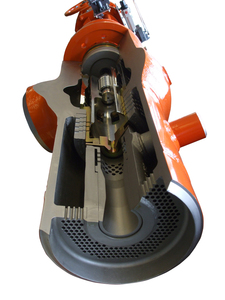

|
Edward Lowton
Editor |


|
| Home> | Plant, Process & Control | >Valves and actuators | >A modern solution to steam conditioning |
A modern solution to steam conditioning
16 February 2024
Technical innovation and leading-edge valve design has improved the conditioning of superheated steam used in power generation and other essential industries, says Mark Wheat

MANY INDUSTRIAL activities rely on steam for their processes, including power generation plants, refineries, and paper mills. The means to generate energy using steam have been understood for centuries. The basic principles, using a boiler, steam turbine and generator, remain largely unchanged. However, the pressures and temperatures involved have increased considerably.
Operational challenges
A steam power plant essentially uses a boiler to generate steam at high pressure and high temperature. A steam turbine converts the heat energy of steam into mechanical energy, and a generator then converts the mechanical energy into electric power.
Water boils at 100ºC under normal atmospheric pressure [0.101 MPa]. As pressure increases, the boiling temperature of water also increases. When the pressure is increased to 22.12 MPa, and at a temperature of 374ºC, water is directly converted into steam. This is called the critical point. Pressure above this critical point, with a temperature equal to or more than 593ºC, is called ultra-supercritical pressure.
Handling superheated steam at these pressures and temperatures places enormous strain on flow control equipment. Inadequately specified valves could lead to inefficiencies through leakages and unplanned outages. What the 21st century required was a valve that could deliver operational reliability and withstand the extreme operating conditions within modern power plants - particularly during plant start-up, shutdown and turbine trips.
A 21st century solution
The DSCV-SA (Direct Steam Converting Valve - Steam Atomization), addresses the issues encountered by older, base load designed bypass valves when employed on modern high frequency, rapid ramp rate plants. Key to the DSCV-SA’s performance are a number of unique technical innovations developed following extensive consultation with power generation customers.
Unlike conventional turbine by-pass valves, the DSCV-SA is designed to use high-pressure balance rather than low-pressure balance. This eliminates risk of wear, damage or breakage relating to piston rings and balancing systems, which are a major problem with traditional valves.
When an open command signal is received, the DSCV-SA actuator retracts and the pilot plug is the first to open. This allows P1 steam to flood through the large pilot plug port to the underside of the main plug, which in turn balances it and reduces the actuation thrusts required.
In traditional low-pressure or P2 balancing designs, auxiliary balancing seals such as piston rings and close tolerance sealing surfaces are needed to prevent the high-pressure steam unbalancing the trim. If these seals or surfaces become worn or damaged, it can unbalance the trim and stem loads can fluctuate dramatically, causing the valve to oscillate violently or not open on command.
When the DSCV-SA pilot plug is open, high-pressure inlet steam floods the underside of the main plug and the steam atomizing unit operates in preparation of the incoming cooling water from the water control valve. The pilot plug shoulder engages with the underside of the tandem cap of the main plug, which then starts to lift and the main seat opens.
Minimising installation space
As the main plug opens, steam first enters the valve via a heavy duty distribution spacer. The steam passes through the spacer by means of numerous holes evenly positioned around the circumference. This distribution spacer is specifically designed to negate any upstream pipework-induced flow disturbance being communicated to the main plug. This is important because long radius bends or isolation valves can be fitted directly to the valve inlet to minimise installation space. The main plug is fully guided by the cage and spacer to ensure complete plug stability through full travel.
After the inlet steam has passed through the distribution spacer, it then travels through the main seat area to the underside of the main plug via large feed ports. With the main plug lifted, the pressure reducing ports of the cage now open to allow the steam to be pressure reduced in a controlled manner. As the main plug opens further, more pressure reducing ports are exposed and the steam flow rate increases.
Mark Wheat is business unit manager at Celeros Flow Technology
For more information:
Tel: +44 1909 482323
- Collaboration allows CME to offer a complete packaging solution
- Steady recovery for subcontracting
- Warning of 'dark days' for car industry as production slumps
- BPMA members support COVID-19 fight back
- From skills shortage to tech triumph
- Bouyant jobs market sees increased churn in manufacturing labour
- NDT 2019 Conference and MT 2019 Exhibition only three weeks away
- thuba spotlights explosionproof emergency stop device
- Making the case for GRP
- Siemens technologies supports plan to create digital chemical facility



















